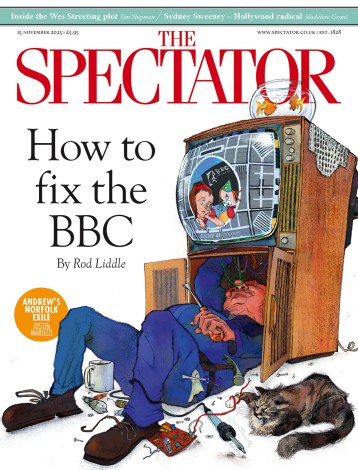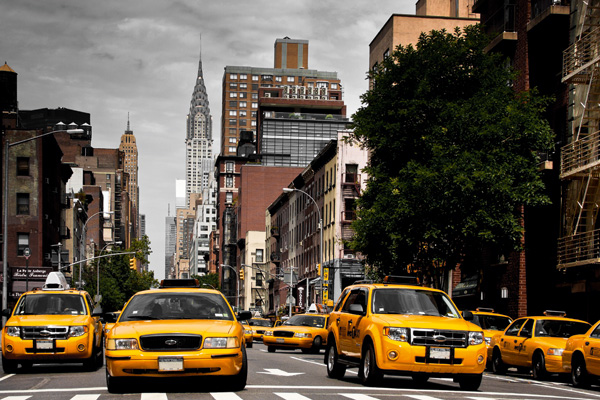Ooh, sir! Do you? At your age, sir? Well, yes. Revolting though it may seem, I still love New York. Every time I go there — as I did earlier this month — I fear I am not going to like it, but every time I fall in love all over again. I think it was Evelyn Waugh who said that when we are young we are Americans, but when we grow up we become Frenchmen. There is some truth in that. Although I cannot claim to have grown up, I do find as I hurtle towards my seventies that I have more in common with cheese-eating surrender monkeys than with Twinkie-scoffing war-losers. Not that I have anything against Twinkies, mind, and, in truth, I remain -rather fond of Americans, among whom I count a wife and a son.
So. New York is flashy, fast, noisy, brash, impudent, venal, bumptious, and dangerous, though not nearly as dangerous as she likes to believe. At the same time, however, she is singularly beautiful, especially on a September day of bright blue skies. On such a day you could walk the city’s streets for ever. Jeffrey Bernard once said after a trip to New York that he hadn’t once seen a skyscraper. You knew what he meant. There’s plenty to occupy your eyes and mind — not to say your adrenal glands and your swordstick — at street level. But look up and you see the most wonderful things. Let’s not be frightened of clichés here: there is surely no art deco in the world to compare with the Chrysler Building (1930), with its Flash Gordon dome and eagle gargoyles; and when you walk down, say, 15th street from Union Square to Fifth Avenue at dawn and look right and see the Empire State Building (1931) all pink and gold in the morning sun, you wonder, just for a moment, whether earth has anything to show more fair.
New Yorkers are supposed to be rude, but I’ve found them polite and helpful, with a sense of decency and decorum
But nearly everything built between the wars is pleasing. The art deco Rockefeller Center (1930–1939) and the Pierre Hotel (1930), a skyscraper with a hint of French château about it, are superb. So, of course, is the extraordinary renaissance and beaux-arts Flatiron Building (1902) on the corner of Fifth Avenue and Broadway. There are scores of such buildings in the city, and their beauty makes one forget the steel-and-glass monstrosities of the past 30 years or so. Among these monstrosities is Freedom Tower, which is now nearing completion at Ground Zero. It puts me in mind of the unspeakable Shard. New York should have built the Twin Towers again, just as they were. You knock it down, we’ll build it again.
The brownstones of Upper Manhattan are as beautiful, in their own way, as the mid-Victorian terraces in the better parts of London, and as romantic, and they put you — me anyway — in mind of Shirley MacLaine and Fred MacMurray in The Apartment. The old tenements of Midtown and Downtown, with their fire escapes at the front rather than at the back, are likewise romantic, in a way that they cannot have been to the huddled masses who once lived in them six to a room. But let’s not overdo it: on a grey day some parts of the city — especially on the West Side — can put you in mind of Kilburn in the 1950s. And the ‘Tudor revival’ stuff in the outer boroughs makes one think not quite of hell, but certainly of purgatory.
New Yorkers are supposed to be rude, but in my experience they are polite and helpful, and have a sense of decency and decorum. In Spanish Harlem I saw a big black fellow in a T-shirt proclaiming: ‘DON’T BRO ME IF YOU DON’T KNOW ME.’ New Yorkers are clever, too. They get things done, but they know when to give up. I got into a stew early one morning when I tried to use a pay phone and could not get my 25 cent coin into the slot. I appealed desperately for help. Those I approached seemed puzzled. ‘The phone won’t take my coins,’ I wailed. ‘What might the problem be?’ The consensus was that the problem might be that the phone was broken. The message: ‘Hey buddy, take it easy. Does your family know you are out?’
We — Mary and I and our son Robert — were in New York not just for the heck of it but to see Mary’s brother Bobby. For almost two years Bobby, who is 66, has been seriously ill and bedridden in a medical facility at the north end of Fifth Avenue. ‘How are you doing, Bobby?’ we say. ‘OK,’ he says, and then starts to tell us about the Holy Roman Empire and his favourite horror films (among them Killer Klowns from Outer Space). He shares his room with a black man who has been unconscious, ‘locked in’, for 18 months or so. This poor fellow is linked up to all sorts of tubes, which from time to time make gurgling and sucking sounds. His mother used to come and sing to him, but she stopped visiting a little while ago. She’d had a stroke, I was told, and was herself now incarcerated in a care home.
Bobby delighted in his nephew, and Robert delighted in his uncle. Robert is now 27 and last visited New York in 1997. On that occasion we were invited to dinner in Connecticut with the late William F. Buckley, Jr, quite the kindest and most courteous man I have ever met, and his extraordinarily glamorous wife Pat, now, alas, also dead. Rob was more hip than I was in those days, and still is. I regaled the table with tales of Tony Blair’s supposed homosexuality — it was a fantasy I shared at the time with Mark Steyn — and illustrated my talk by camping it up. No one at the table seemed amused, not even Pat’s bridge partners, two nice, witty, good-looking young men with jumpers over their shoulders. There was much earnest staring at plates. On the way back to New York, Mary said: ‘Are you crazy? Couldn’t you see that those two guys are gay?’ ‘Yeah, Dad,’ said Rob reproachfully.
This time Rob had less reason to be reproachful. He mastered the subway and most evenings went down to Greenwich Village to, er, chill. He smokes roll-ups and was constantly asked as he stood outside bars with his ciggie whether he was smoking dope. One observer, sensing a business opportunity, sidled up to him and said: ‘Hey, man, would you like some weed to go with those papers?’ ‘It was just like Peckham,’ said Robert. He loved it.






Comments